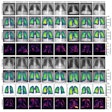In an official report, state health authorities in New Hampshire say that officials and staff at Exeter Hospital had lax procedures and missed multiple warning signs in the case of a cardiac cath lab technologist who infected dozens of patients with hepatitis C as part of an alleged drug diversion scheme.
David Kwiatkowski is currently awaiting trial in New Hampshire on charges that he stole fentanyl intended for use in anesthetizing patients undergoing cardiac cath procedures and diverted it for his own use. Kwiatkowski is believed to have infected patients in a number of other states where he worked as a traveling technologist in a case that has exposed the patchwork of regulations in the U.S. covering traveling healthcare workers.
In the case of Exeter Hospital, last week's report found evidence that Exeter staff ignored signs that syringes had been tampered with; didn't investigate cases in which fentanyl syringes were found in parking garages, restrooms, and under hospital equipment; and failed to test Kwiatkowski for drug use despite "significant concerns" raised by co-workers.
Fentanyl diversion
Kwiatkowski was arrested in July 2012 following an investigation of an outbreak of hepatitis C at Exeter Hospital, a 100-bed community hospital in New Hampshire. The infected patients had the same strain of hepatitis C as Kwiatkowski; further investigation found that he had been fired from several previous technologist positions in other states -- in at least one case, after being suspected of diverting narcotics intended for patients.
In its June 21 report, the New Hampshire Department of Health and Human Services summarized the outbreak and provided an overview of the procedures that had been in place at Exeter Hospital, as well as the hepatitis testing program that followed.
Of the 1,074 patients who were tested, 32 were identified with the same strain of hepatitis C as Kwiatkowski. Another 27 patients showed evidence of past hepatitis C infection, while four were categorized as "probable" infections and five as "suspect" cases based on epidemiological information. While a number of patients who had been treated in the cardiac cath lab had died since the outbreak, none of the deaths were believed to be related to hepatitis C infection from Kwiatkowski.
The report found that the only plausible explanation for 32 patients being infected with the same strain of hepatitis C is that they were exposed to a single individual through a "penetrating exposure," such as by a contaminated needle.
The report focused on procedures in the cardiac cath lab where Kwiatkowski worked, as well as an adjacent recovery room for patients.
Controlled substances such as fentanyl were prepared using a Pyxis medication management machine, with access to the machine supposedly restricted to key personnel. However, there was no restriction to the procedure room for staff members who weren't assigned to a case, and they could come and go without being restricted or documented. Four employees told investigators that Kwiatkowski was commonly seen in the procedure room, "assisting" staff, even when not assigned to patient cases.
There were also no procedures to lock up drawn medications until it was time for them to be used, and there was no practice to lock up syringes with remaining medicine left over after initial use; syringes would be kept on top of the Pyxis machine.
There were also variations in how Exeter personnel dealt with leftovers and wastage of controlled substances. The investigation revealed 16 cases in which a total of 21 full vials were wasted; 18 of these vials were wasted by a nurse who was reported to have a close relationship with Kwiatkowski and who had previously lived with him. These concerns were reported to Exeter management, but investigators found no documentation for corrective actions taken at the hospital.
In a review of 74 procedure records, nine procedures (12%) had discrepancies in controlled substances, including four cases where full vials were missing. Investigators found documentation or procedural problems with most of these cases.
Suspicious occurrences
The report also documented cases in which suspicious occurrences were not investigated at Exeter. Empty fentanyl syringes were found in the hospital's parking garage, under the Pyxis machine, and in a restroom near the cardiac cath lab, and in another case a nurse found evidence that fentanyl vials had been tampered with. But Exeter did not conduct any unannounced drug testing of employees, and the nurse said she felt her concerns were dismissed by the pharmacy.
Exeter had in place a narcotic oversight policy that defined drug testing "for cause," such as if an employee were suspected of drug use. But the hospital didn't implement the policy in Kwiatkowski's case, despite "significant concerns of drug use ... raised by co-workers." His only drug test on file was his initial negative drug test upon hire as a traveling technologist in April 2011, according to the report.
The investigation found that seven of 28 patients who were supposed to be receiving fentanyl reported experiencing "higher than usual pain" during their procedures. Three of them had undergone previous procedures and could compare the level of pain between their studies.
Finally, the cardiac cath lab's recorded use of fentanyl jumped during the hepatitis outbreak, to levels two and three times higher than in previous periods that were sampled. From January to March 2011, the lab used an average of 72 µg of fentanyl per patient, and from January to March 2012, use was 101 µg. During the outbreak, the average per-patient dose was recorded as being 226 µg.
The report concludes with a series of recommendations on how to prevent and detect drug diversion, including stricter access to controlled substances and better procedures for their administration and disposal of waste after use. The report also recommends the integration of all patient information into a single system, rather than keeping data in a silo like the Pyxis system that is separate from electronic medical records, the Mac-Lab system used in the cath lab, and paper records.
The full report can be reached by clicking here.



















